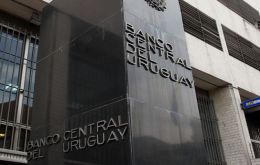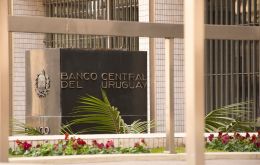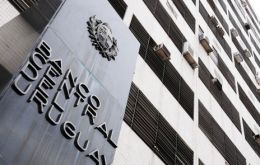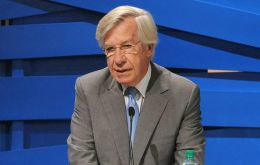MercoPress. South Atlantic News Agency
Tag: Central Bank of Uruguay
-
Thursday, October 2nd 2014 - 07:06 UTC
Uruguay's fiscal deficit 'relatively' stable at 3.3% of GDP

Uruguay's fiscal deficit in the twelve months to August was equivalent to 3.3% of GDP, or 1.725bn dollars according to the latest release from the Economy and Finance ministry. However the primary deficit (before debt payments) was 202 million dollars or 0.39% of GDP.
-
Tuesday, September 16th 2014 - 05:25 UTC
Uruguay's economy expands 3.7% during the second quarter over a year ago

Confirming ten years of sustained expansion the Uruguayan economy advanced 2% in the second quarter over the first quarter and 3.7% over the same period a year ago, according to the latest reports from the Central bank.
-
Friday, July 11th 2014 - 01:37 UTC
Uruguay central bank admits inflation remains the main concern and pledges monetary contraction

Uruguay's Central bank confirmed that inflation remains the leading challenge and ratified the current monetary contractive policy with the M1 money supply index converging to 8% from its current 10.4%, in a 'not too distant horizon'.
-
Saturday, July 5th 2014 - 09:13 UTC
Uruguay's inflation index for June slightly down: 9.08% in twelve months

Uruguay's inflation index experienced a slight deceleration during the twelve months to June, from 9.18% in May to 9.08%, basically because of cheaper fresh food, frozen public utility rates including fuel, while a stabilized exchange rate for the US dollar with a strong Peso, helped with imported goods.
-
Wednesday, June 18th 2014 - 08:31 UTC
Uruguay economy growing at a slower pace: imports up; exports stagnant

Uruguay's economy expanded 2.4% in the first quarter compared with the same 2013 period, but contracted 0.4% compared with the fourth quarter of last year, the central bank said this week. However deceleration is a fact since growth of the first quarter in 2013 has gone up 4.6% over 2012.
-
Wednesday, June 11th 2014 - 01:48 UTC
Uruguay issues 2 billion dollars of new 2050 global bond to help spread the country's debt

Uruguay issued 2 billion dollars of a new 2050 global bond on Tuesday at a spread of 165 to 170 basis points over U.S. Treasuries as part of the government's bid to put less strain on its accounts in the near- and medium-term, it was reported.
-
Monday, March 31st 2014 - 19:42 UTC
Uruguay and Peru in line for a possible upgrading, according to Moody's

Uruguay and Peru are the first Latin American countries in line for a possible credit rating hike by Moody's Investors Service, at a moment when sovereign upgrades are expected to become more scarce in the region, a senior analyst with the ratings firm said.
-
Monday, November 18th 2013 - 18:33 UTC
Astori forecasts Uruguay's inflation in the range of 3 to 7% in the next two years

Vice-president Danilo Astori confirmed that Uruguay will continue with its current flexible foreign exchange policy, because “this has helped us reduce volatilities”, but also admitted concern about inflation, the third highest in South America and fourth in Latin-American and the Caribbean.
-
Wednesday, September 4th 2013 - 00:36 UTC
Food, education and healthcare rising prices keep Uruguay’s inflation out of target

Uruguay’s inflation in August kept climbing and reached 1.04%, totalling 6.74% in the first eight months of the year and 8.86% in the last twelve months, which is well above the Central bank target of 4% to 6%, according to the latest report from the local Statistics Office, INE.
-
Tuesday, August 6th 2013 - 03:05 UTC
Inflation in Uruguay remains ever so far from the Central bank annual target

Consumer prices in Uruguay during July increased 0.77% while twelve-month inflation reached 8.75%, which is the highest since last February, and well ahead of the 8.21% to June, according to the latest release from the country’s National Stats Institute, INE.
